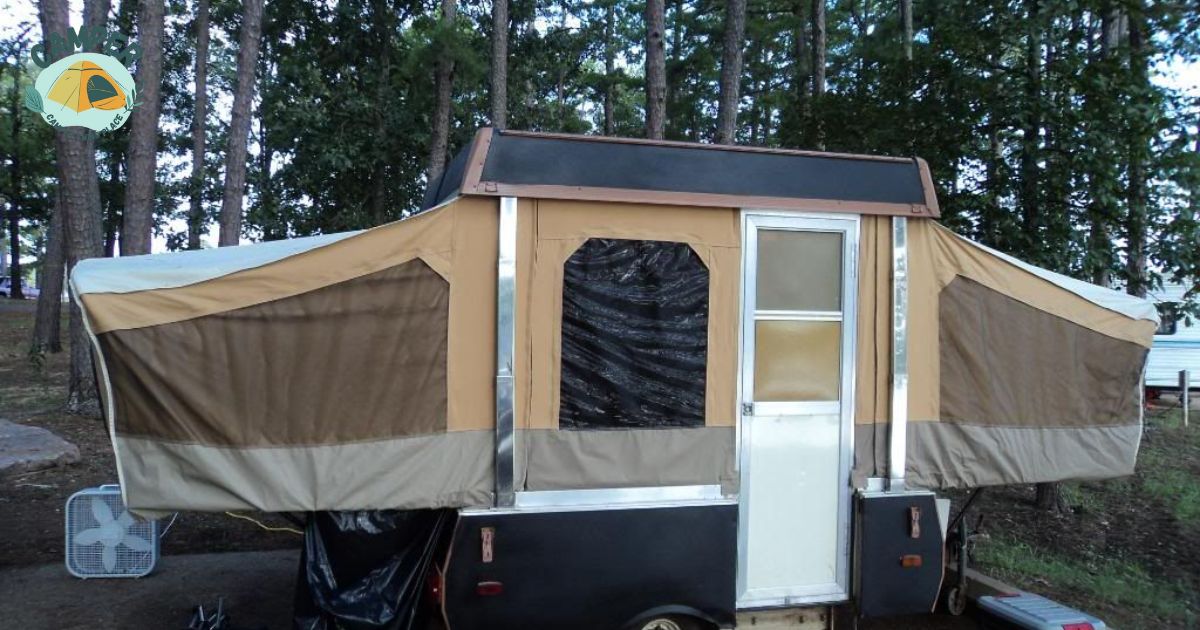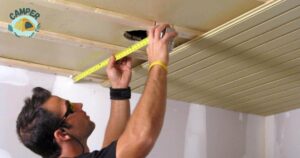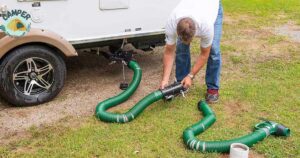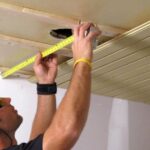A pop-up camper is a compact, towable recreational vehicle that collapses for easy storage and expands for camping. It combines the convenience of a trailer with the flexibility of collapsible elements, offering a cozy yet portable camping experience.
Replacing the canvas on a pop-up camper involves the cost of new canvas material and labor for installation. Here is a most asked question from the people how much does it cost to replace canvas on a pop-up camper? Prices vary based on camper size and canvas quality, ranging from a few hundred to over a thousand dollars.
The expense associated with replacing the canvas on typical pop-up campers typically falls within the range of $1000 to $2000. Additionally, there is an anticipated expenditure of $300 to $500 for professional installation. The necessity for a complete canvas replacement may vary based on the extent of damage or the overall condition of the existing canvas sections.
Numerous companies provide discounted prices for bulk canvas purchases, and specialized recanvasing professionals may offer comprehensive pricing that encompasses materials, installation, and labor costs, especially if they have canvas readily available.
What is the Cost of Replacing a Pop-Up Camper’s Canvas?
The total cost of replacing the canvas for your pop-up camper depends on various factors.
To begin with, you should assess the extent of canvas replacement needed for your pop-up camper, whether it involves the entire canvas or only specific parts.
Next, you must weigh the cost-effectiveness of performing the replacement yourself versus hiring a professional to recanvas your camper.
If you opt for a complete replacement of the canvas on your pop-up trailer, additional considerations come into play that influence the overall cost.
While most pop-up campers share similarities, each manufacturer incorporates distinct design features and size specifications for wings and canopies.
The quantity of canvas required for the recanvasing project will vary from one trailer to another.
Besides the manufacturer and model, the camper’s year can also impact its design.
Typically, older pop-up camper designs tend to cost around $1000 for a comprehensive recanvasing, whereas newer models often approach or exceed $1500.
DIY vs. Paid Replacement
Consider these factors to decide which approach aligns better with your preferences, skills, and budget.
| Aspect | DIY Replacement | Paid Replacement |
| Cost | Can be more budget-friendly, as you handle labor and materials yourself. | Tends to be more expensive, incorporating professional labor and material costs. |
| Skill Required | Requires moderate to advanced DIY skills, sewing or fabric installation knowledge. | Professional expertise is provided, minimizing the need for specific skills on your part. |
| Time Investment | Time-consuming, especially if you’re new to the process. | Quicker turnaround time as experienced professionals handle the replacement. |
| Quality | Depends on personal skill and attention to detail. | Generally higher quality due to professional experience and equipment. |
| Convenience | Offers flexibility but demands personal commitment and effort. | Provides convenience, saving you time and effort, but at a higher cost. |
| Warranty and Guarantees | Typically, limited or no warranties on your own work. | Professionals may offer warranties or guarantees on their services and materials. |
| Customization Options | Greater flexibility to customize based on personal preferences. | Limited customization compared to DIY, but may offer some choices. |
| Risk of Errors | Higher risk of errors, especially for beginners. | Lower risk as professionals are trained to avoid common mistakes. |
Ultimately, the responsibility lies with you and your proficiency. If you are self-assured in your ability to execute it accurately on the initial attempt, you stand a chance to economize a few hundred dollars.
Alternatively, seeking the assistance of professionals specializing in reevaluation can expedite the process, completing it within an hour or, at the latest, in a single day, typically costing between $300 and $500.
How Much Will It Cost To Replace The Fabric On My Camper
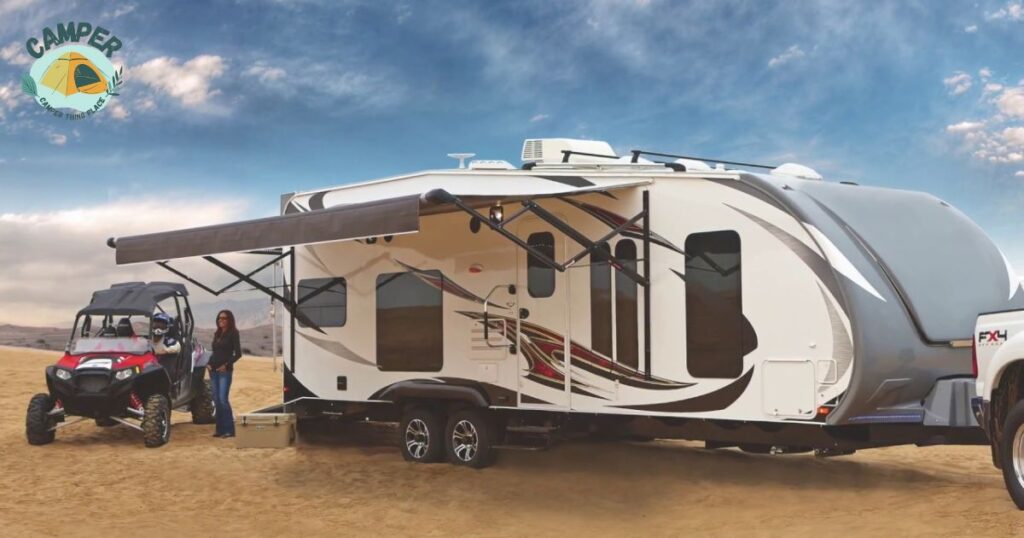
The cost of replacing the canvas on your popup trailer ranges from $800 to $1500, depending on various factors.
- Firstly, the size of your camper matters. A larger camper means more fabric, and consequently, a higher cost.
- The type of fabric you choose influences the price. High-quality materials might cost more upfront, but they often offer better durability in the long run.
- Consider the complexity of your camper’s design. Intricate shapes and features might require more labor, impacting the overall cost.
- Don’t forget the brand. Some camper fabric brands come with a premium price tag, so choose wisely based on your budget and preferences.
- Location matters too. Labor costs vary by region, so it’s essential to factor in the local rates for installation.
- Lastly, additional features like zippers, screens, or special coatings can contribute to the overall expense.
- To estimate the cost accurately, it’s best to consult with professionals and get quotes based on your specific camper and preferences.
How Do You Know It’s Time To Replace The Canvas On Your Camper?
Knowing when it’s time to replace the canvas on your camper involves paying attention to certain signs. Here’s a guide:
Visible Wear and Tear:
Check for visible signs of wear and tear such as holes, rips, or extensive fading. If the canvas looks worn out and patching won’t suffice, it’s time to consider replacement.
Water Leakage:
If you notice water leaks during rain or after washing, it indicates that the canvas might have lost its waterproofing. This is a clear sign that replacement is necessary to maintain a dry interior.
Mold and Mildew:
Persistent mold or mildew growth despite cleaning efforts may indicate that the canvas has become too porous. Replacement becomes crucial to prevent health issues and further damage.
Difficulty in Operation:
If the canvas is becoming challenging to zip or unzip, or if the mechanisms for rolling or folding are not working smoothly, it suggests that the material has weakened and replacement is in order.
Sun Damage:
Prolonged exposure to sunlight can cause canvas material to weaken and lose its color. If you notice significant sun damage, consider replacing the canvas to enhance both aesthetics and functionality.
Odors:
Persistent musty odors that linger even after thorough cleaning may be a sign of deep-seated issues within the canvas. Replacement can help eliminate unpleasant smells and improve overall comfort.
Age of the Canvas:
Consider the age of the canvas. If it’s reaching the end of its expected lifespan, even without visible damage, it might be wise to replace it preventively.
Deterioration of Seams and Stitching:
Check the seams and stitching. If you observe fraying or unraveling, it’s an indication that the canvas structure is compromised, necessitating replacement. Additionally, consider the weight capacity of your pop-up camper bed.
Understanding the weight limit is crucial to ensure the safety and durability of the bed. Regular inspections and addressing issues promptly can prolong the life of your camper’s canvas and bed.
When in doubt, seeking the advice of professionals can provide a clearer assessment of whether replacement is the best course of action.
What Kind Of Canvas Do You Use On a Pop-Up Camper?
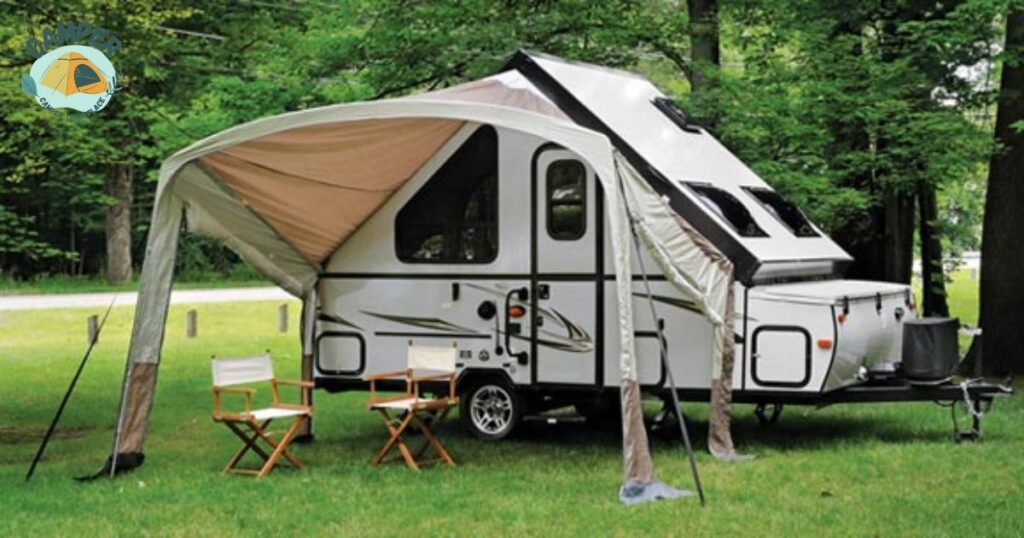
Choosing the right canvas for a pop-up camper is crucial for durability, weather resistance, and overall performance. Here are common types of canvas materials used:
Cotton Canvas
Traditional and breathable, cotton canvas provides a comfortable camping experience. It’s usually treated with waterproof coatings to enhance water resistance. However, it may require more maintenance to prevent mildew and mold.
Polyester Canvas
Polyester canvas is known for its strength and resistance to UV rays. It often comes with coatings like polyurethane for waterproofing. Polyester is less prone to mildew and can be a low-maintenance option.
Cotton-Poly Blend
A blend of cotton and polyester combines the breathability of cotton with the durability and water resistance of polyester. This type of canvas seeks to offer a balance between comfort and performance.
Vinyl-Coated Canvas
Vinyl-coated canvas is highly waterproof and durable. It’s a popular choice for those looking for maximum protection against the elements. However, it may be less breathable compared to natural fabric options.
Sunforger Canvas
Sunforger canvas is a cotton canvas treated with a special finish that enhances its resistance to water, mildew, and UV rays. It aims to provide a breathable yet weather-resistant option.
When choosing a canvas for your pop-up camper, consider factors such as climate, frequency of use, and personal preferences. Each type of canvas has its advantages, and the right choice depends on your camping habits and the conditions you expect to encounter.
It’s also important to check the seams, stitching, and zippers, as the overall construction plays a significant role in the canvas’s performance. Always follow manufacturer recommendations for care and maintenance to extend the life of your pop-up camper’s canvas.
What Other Fabrics Are Worth Considering For Pop-Up Campers?
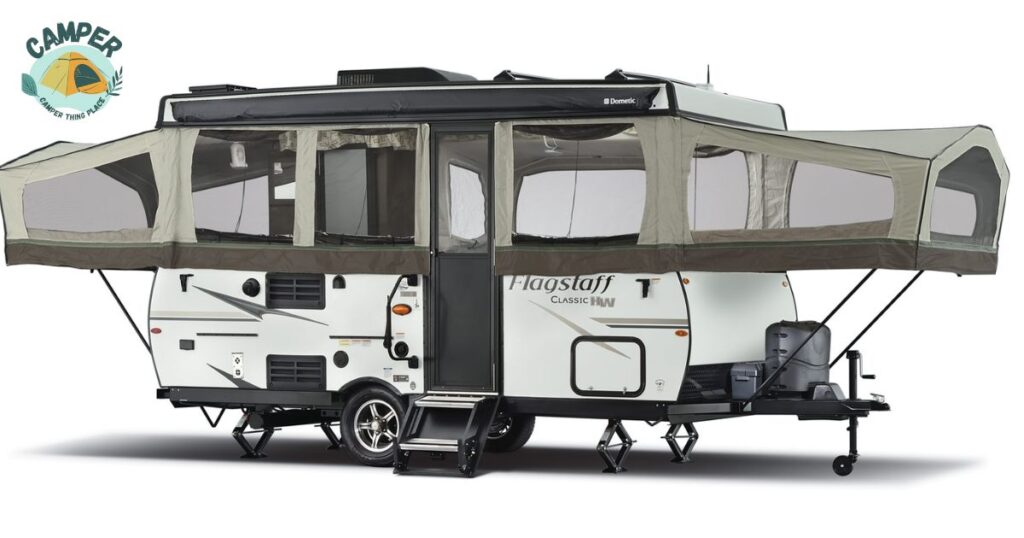
Apart from traditional canvas materials, several other fabrics are worth considering for pop-up campers. Each comes with its unique set of characteristics, offering different benefits based on your camping needs:
Acrylic Fabric
Acrylic fabric is known for its resistance to UV rays, mildew, and water. It provides durability and colorfastness, making it an excellent choice for campers exposed to sunlight.
Nylon Fabric
Nylon is lightweight, quick-drying, and resistant to mildew. It’s a popular choice for pop-up camper materials, especially for tent components, due to its strength-to-weight ratio.
Polyethylene
Polyethylene is a durable and waterproof material commonly used in camper covers. It provides excellent protection against the elements and is resistant to UV rays.
Sunbrella Fabric
Sunbrella is a solution-dyed acrylic fabric known for its exceptional durability and UV resistance. It’s often used in awnings and canopies for pop-up campers.
Oxford Fabric
Oxford fabric is a polyester or nylon blend known for its strength and durability. It’s commonly used in camper covers and awnings due to its resistance to abrasion and tearing.
Ripstop Nylon
Ripstop nylon is reinforced with a grid pattern to prevent tears from spreading. It’s lightweight and durable, making it suitable for various camping applications.
PVC-Coated Polyester
Polyester fabric coated with PVC provides excellent waterproofing and durability. It’s often used in camper covers and awnings for its weather-resistant properties.
Dyneema Composite Fabric (DCF)
DCF is an ultralight and exceptionally strong fabric made from Dyneema fibers. While it’s more commonly used in backpacking gear, it might find applications in lightweight camper components.
When selecting a fabric for your pop-up camper, consider factors such as weight, durability, water resistance, and UV resistance. Additionally, pay attention to the construction and overall quality of the material to ensure it meets your specific camping requirements.
What To Know To Get The Most Out Of Your Pop-Up Trailer Canvas?
Getting the most out of your pop-up trailer canvas involves a few key things to keep in mind. First, know your canvas material. Whether it’s cotton, polyester, or a blend.
Understand its strengths and maintenance needs. Regularly inspect for wear, tear, or mold. Stay on top of cleaning to prevent mildew.
Know the limits of your canvas regarding weather. While some are more water-resistant, others excel in UV protection. Tailor your camping plans accordingly.
Learn the proper way to set up and take down your canvas. Following manufacturer guidelines ensures longevity.
Invest in good care products. Waterproofing sprays and cleaners designed for your specific canvas material can enhance performance.
When not in use, store your pop-up trailer with care. A clean and dry canvas during storage prevents damage.
Lastly, embrace preventive measures. Small repairs and timely attention to issues can extend the life of your canvas, ensuring many more enjoyable camping trips.
How To Prevent Damage To Your Canvas?
- Check the canvas regularly for signs of wear, tear, or mold.
- Clean the canvas according to manufacturer recommendations to prevent the buildup of dirt, grime, and mildew.
- Store the pop-up trailer with the canvas clean and dry to avoid long-term damage during periods of non-use.
- Be mindful of weather conditions. If heavy rain is expected, ensure the canvas is properly secured and angled to prevent water pooling.
- Use waterproofing sprays or treatments suitable for your canvas material to enhance its water resistance.
- Limit prolonged exposure to direct sunlight to prevent color fading and material degradation.
- Follow manufacturer guidelines for setting up and taking down the canvas to prevent undue stress on seams and zippers.
- Address any small tears or issues promptly to prevent them from becoming more significant problems.
- Consider using protective covers or awnings to shield the canvas from harsh weather elements when the pop-up trailer is stationary.
- Choose campsites with level ground to avoid unnecessary stress on the canvas during setup.
- Keep sharp objects away from the canvas to prevent accidental punctures or tears.
- Follow to weight limits specified by the manufacturer to avoid overburdening the canvas and its support structures.
Understand the specific care requirements of your canvas material and follow best practices accordingly.
DIY Canvas Repair On a Pop-Up Camper
Repairing the canvas on your pop-up camper can be a satisfying DIY project. Here’s a guide in easy steps:
- Start by carefully examining the canvas for any tears, holes, or worn-out areas. Identify the extent of the damage.
- Collect the necessary materials for the repair, including a canvas repair kit, fabric patch, adhesive, and any tools needed for the job.
- Clean the damaged area thoroughly to ensure proper adhesion. Remove any dirt, grime, or loose threads that could interfere with the repair.
- Cut a patch from the repair fabric, ensuring it’s slightly larger than the damaged area. Round the corners to prevent peeling.
- Use the adhesive provided in the repair kit to apply a thin, even layer to both the patch and the damaged area. Follow the instructions on the adhesive product.
- Carefully place the patch over the damaged area, ensuring a smooth and secure fit. Press down firmly to promote adhesion.
- Let the repaired area dry thoroughly according to the adhesive’s recommended drying time. Avoid exposing the repair to stress during this period.
- For added durability, consider applying a second layer of adhesive over the patch. This step can provide extra strength to the repair.
- Once fully dry, gently test the repaired area to ensure it can withstand normal usage. Check for any signs of weakness or peeling.
- If the repair involves a waterproof canvas, consider applying a waterproofing spray to maintain or enhance the water resistance of the treated area.
Remember to follow the specific instructions provided with your repair kit and take your time to ensure a thorough and effective DIY canvas repair on your pop-up camper.
Where to Purchase Pop-Up Camper Canvas Replacements?
Numerous professional services specialize in camper canvas replacement, and here are a few recommendations from fellow weekend warriors.
Fabricover simplifies the process by allowing you to input your VIN, make, or model to determine the precise cost for your canvas replacement. Additionally, they provide free shipping within the United States.
Bear Creek Canvas stands out as a highly reputable option for canvas replacement, featuring a transparent pricing structure and often being one of the most cost-effective choices available. They also offer the option to create a custom template based on your old canvas.
As suggested by its name, Popup Parts offers a range of replacement parts for campers, including canvas. Utilizing high-quality materials made in the USA, they cater to a diverse array of makes and models, ensuring reliable service.
Frequently Asked Questions
Can you replace canvas on pop up?
Yes, you can replace the canvas on a pop-up.
How do you fix a canvas on a pop up camper?
Repair a canvas on a pop-up camper by patching holes with fabric repair tape or using a canvas repair kit for larger tears.
Can you replace canvas on a camper?
Yes, you can replace the canvas on a camper by removing the old canvas and installing a new one.
Final Thoughts
The cost to replace canvas on a pop-up camper varies. Online options like Amazon or Camping World and local RV dealerships are good places to check.
Prices can differ, so shop around for the best deal. Keep an eye out for discounts. With some research, you can find a replacement that fits your budget. Happy camping with your refreshed pop-up camper.

Jackson Ray, a seasoned blogger with a decade of experience, is the creative mind behind “camperthingsplace.com.” Explore his wealth of insights and passion for camping through engaging content on the website.
